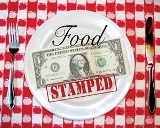 The 2009 Recovery Act’s temporary boost to Supplemental Nutrition Assistance Program (SNAP) benefits is scheduled to end on November 1, 2013, resulting in a benefit cut for every SNAP household. For families of three, the cut will be $29 a month – a total of $319 for November 2013 through September 2014, the remaining months of fiscal year 2014. That’s a serious loss, especially in light of the very low amount of basic SNAP benefits. Without the Recovery Act’s boost, SNAP benefits will average less than $1.40 per person per meal in 2014. Nationally, the total cut is estimated to be $5 billion in fiscal year 2014.
The 2009 Recovery Act’s temporary boost to Supplemental Nutrition Assistance Program (SNAP) benefits is scheduled to end on November 1, 2013, resulting in a benefit cut for every SNAP household. For families of three, the cut will be $29 a month – a total of $319 for November 2013 through September 2014, the remaining months of fiscal year 2014. That’s a serious loss, especially in light of the very low amount of basic SNAP benefits. Without the Recovery Act’s boost, SNAP benefits will average less than $1.40 per person per meal in 2014. Nationally, the total cut is estimated to be $5 billion in fiscal year 2014.
It seems unlikely that Congress will enact legislation to remedy this problem, as President Obama and some members of Congress have proposed. Consequently, states need to prepare for the benefit cuts – including determining how they will provide information about the upcoming benefit reduction to participating households and other stakeholders as well as how to manage increased client inquiries when the cut takes effect.
In response to the economic downturn, the American Recovery and Reinvestment Act of 2009 (ARRA) increased Supplemental Nutrition Assistance Program (SNAP) benefits across the board as a way of delivering high “bang-for-the-buck” economic stimulus and easing hardship. ARRA increased SNAP maximummonthly benefits by 13.6 percent beginning in April 2009. Benefits increased for all participating households and by the same amount by household size (except for those households that qualified for the minimum benefit) in 2009. For example, for a one-person household, the added benefit was $24 a month; for two persons, it was $44 a month; for three persons, it was $63 a month; and for four persons, it was $80 a month. The minimum benefit (which is available to eligible one- and two-person households that otherwise qualify for a small benefit or no benefit) rose from $14 to $16. Because households that receive less than the maximum benefit received the same fixed dollar increase, the increase to average benefits was larger in percentage terms: about 20 percent.
ARRA provided that SNAP benefit levels would continue at the new higher amount until the program’s regular annual inflation adjustments to the maximum SNAP benefit exceeded those set by ARRA. The maximum SNAP benefit levels for each household size, which are set each October 1, are equal to the cost of the Thrifty Food Plan (TFP) from the preceding June scaled to each household size. The TFP is the cost of U.S. Department of Agriculture’s (USDA) food plan for a family of four to purchase and prepare a bare-bones diet at home. At the time ARRA was enacted, food price inflation was expected to be high and the TFP cost was expected to exceed the ARRA level in fiscal year 2014. Food price inflation, however, turned out to be lower than expected over the 2009 to 2013 period, resulting in the pushing out of the date that the TFP was expected to exceed the ARRA level.
In August 2010, Congress passed and the President signed P.L. 111-226, which accelerated the sunset of the ARRA benefit increase to April 2014 and used the estimated savings for state fiscal relief through additional federal funding for school districts to maintain teachers’ jobs and maintaining a higher federal match for Medicaid costs. Four months later, the Healthy Hunger-Free Kids Act (P.L. 111-296), which reauthorized Child Nutrition programs, further accelerated the sunset date of ARRA to October 31, 2013, to offset the cost of the legislation. As a result, beginning on November 1, 2013, SNAP benefit levels will be based on the cost of the June 2013 TFP, which is lower than the ARRA levels.
On August 1, 2013 USDA published the June 2013 TFP – $632 – a $36 decrease from the current maximum monthly benefit for a family of four under ARRA. This significant benefit cut will likely cause hardship for many households. The total size of the cut will be approximately $5 billion in fiscal year 2014 and, based on the Congressional Budget Office’s May 2013 projections for food inflation in coming years, an additional $6 billion across fiscal years 2015 and 2016.
The cuts are especially painful in light of the inadequacy of existing benefit levels. In a report issued by the Institute of Medicine and the National Research Council, nutrition experts identified several shortcomings with the current SNAP benefit allotment; noted that most household benefit levels are based on unrealistic assumptions about the cost of food, time preparation, and access to grocery stores; and recommended evaluating ways of changing the benefit calculation to better ensure that households have enough resources to purchase an adequate diet.
SNAP has never experienced a reduction in benefit levels that affected all participants. There have been some cuts in specific states, but these cuts have not typically been as large or affected as many people as what will occur this November.
These cuts will likely cause hardship for some SNAP participants, who will include 22 million children in 2014 (10 million of whom live in “deep poverty,” with family incomes below half of the poverty line) and 9 million people who are elderly or have a serious disability. Cutting these households’ benefits will reduce their ability to purchase food. This cut will be the equivalent of taking away 21 meals per month for a family of four, or 16 meals for a family of three, based on calculations using the $1.70 to $2 per meal provided for in the Thrifty Food Plan. USDA research has found that the Recovery Act’s benefit boost cut the number of households in which one or more persons had to skip meals or otherwise eat less because they lacked money – what USDA calls “very low food security” – by about 500,000 households in 2009.
More recent research finds that boosting SNAP benefits during the summer for households with school-aged children who don’t have access to USDA’s summer food program cut very low food security among these households by nearly 20 percent.
Given this research and the growing awareness of the inadequacy of the current SNAP benefit allotments, we can reasonably assume that a reduction in SNAP benefit levels of this size will significantly increase the number of poor households that have difficulty affording adequate food this fall. Read more here.
{Andy Heller-Matzav.com Newscenter}












Lets see how many Matzav readers
will comment on this cut by the goverment
as they have commented on the cuts
made by the Isralie goverment on child
welfare payments.
My heart goes out to them! I think a little about me too! I’ve got no food stamps, no Section 8 and no Medicaid! I pay for my family’s food, living costs and food bill out of my pocket and salary! Atop all the other things that we have to pay for including co-pay at the doctor’s office and enormous co-pay at the pharmacy – medicaid recipients pay no co-pay (maybe $2.. or $5.00). When my kids need braces I have to figure out if I can do it or not and if it is absolutely necessary or not. Yet when I come before the tuition committee, since I have a job, I pay the premium rate! I know the school needs the money to run, but my point is, these “QUOTE/END QUOTE” needy recepients of government freebies and hand-outs ought pay more. I don’t get lunch program for free – my kids, one brings a sandwich every day the others don’t want to be different and want school lunch, so I pay. I feel badly that they’re getting cut but so am I getting cut because my costs of living went up and my salary didn’t! I can’t go around asking help to make my son’s Bar Mitzva and I can’t get away with a little one either cuz I’m a “Baaleboss” and I can’t get help with my daughter’s upcoming chasuna either! I ain’t no rich guy at all! I struggle every month but I’m a “Baaleboss” so …..
Is Lapid the Finance Minister in the US too?
instead of cutting the poor people – take off the people who dont belong on it
#1/Amalek
If the Isreali government was making such a nominal cut to a recently expanded program and wouldn’t be saying anything or doing else against Chareidim I would have no problem with it.
If you think these cuts are a good idea, think again. It’s not just “yenem” (“the other guy”) that’s going to get cut. It’s also going to be plenty of frum families – kollel famliies, large families, seniors, single mothers, disabled, and so forth. Current food stamp benefits are already inadequate. With cuts, there will be a disaster. Who is going to put up the money to feed our hungry? (People who whine they can’t find the money to spend for a baaleboss bar mitzvah?) Yes, we pay taxes, and yes, we get some of those taxes back. And many people with low incomes and large families don’t pay very much in tax to begin with.
Question: How are we going to make up the deficit in our own communities?
#6
As someone who works my answer is let the people on food stamps limit themselves to the foods I can afford to buy.When I see the people on the programs have such a higher standard of living then I do, I have zero sympathy for them and their cuts.
I think people need to stay on foodstamps the ones that need their foodstamps is the ones that got caught in the past selling their foodtamps and if u are under doctor care and have help problems like dealing with depression need to be on them and get more
I am a mother and wife. I have three children. I am the only one working because we have two children and home and a Kindergardener. I have rent, electric, water, car insurance, and car payment. I don’t have a phone–even though I really need one for my job. I do pay for internet so I can pay bills and budget my account. I also have to pay for diapers, wipes, clothes every few months because my children are growing fast, doctor visits, toilet paper, cleaning supplies, gas, hygiene products…. If I didn’t have food stamps… I would have a total of around $50 a month for food for a family of 5. If my husband got a job, that would be more expenses… more gas, more for insurance (bc I only pay for myself since I am the only one driving), plus 200 – 300 more a week because our kids would need to be in daycare. I don’t want to be on food stamps forever, but I don’t even get enough food for our family. Most days, I don’t even eat, just so my family can have food in their bellies. Doctors say my kids aren’t even gaining enough weight. So obviously, I’m not living like a King because I get a little bit of help. Yes, I have made mistakes, but I’m trying my hardest to take care of my family.
im glad that they are doing this because there are alot of people on this program that doesnt really need it and have brand new cars live in low income homes that goverment should be more harder on them because they are showing them to keep living on it insted sending them to do more free community work to replace what they are given
I had to laugh at the lady that stated she has a computer to pay bills and to budget. You have got to be kidding me. This is an example of why there is no sympathy for the ‘poor people in need of food stamps’ and I’ve got news for you toots. Your husband CAN get a job!
I know a family of three they get food stamps, and they feed all their pets to like seven of them do eat better then sometimes what I eat, and I don’t get any assistance at all.